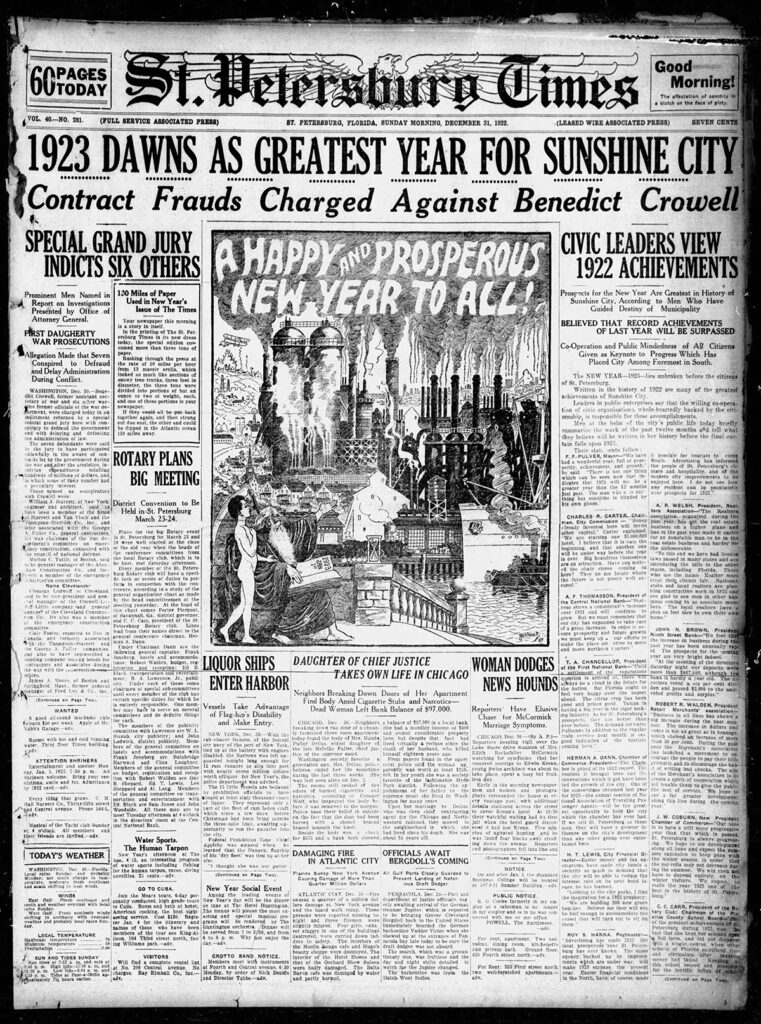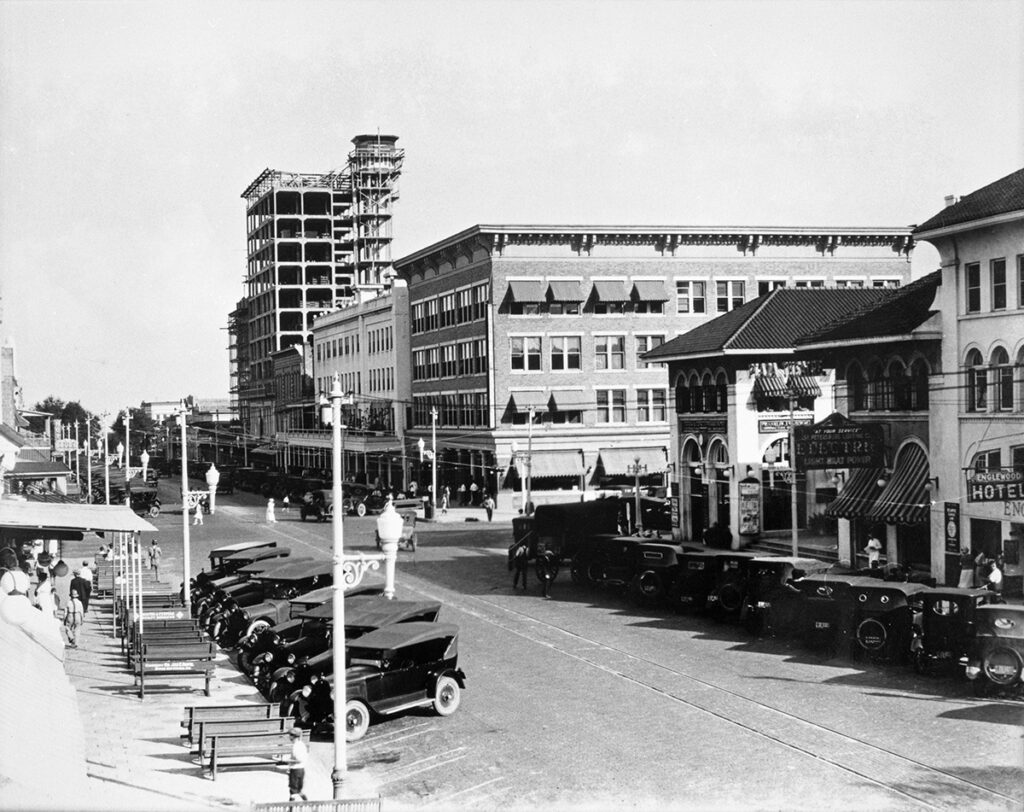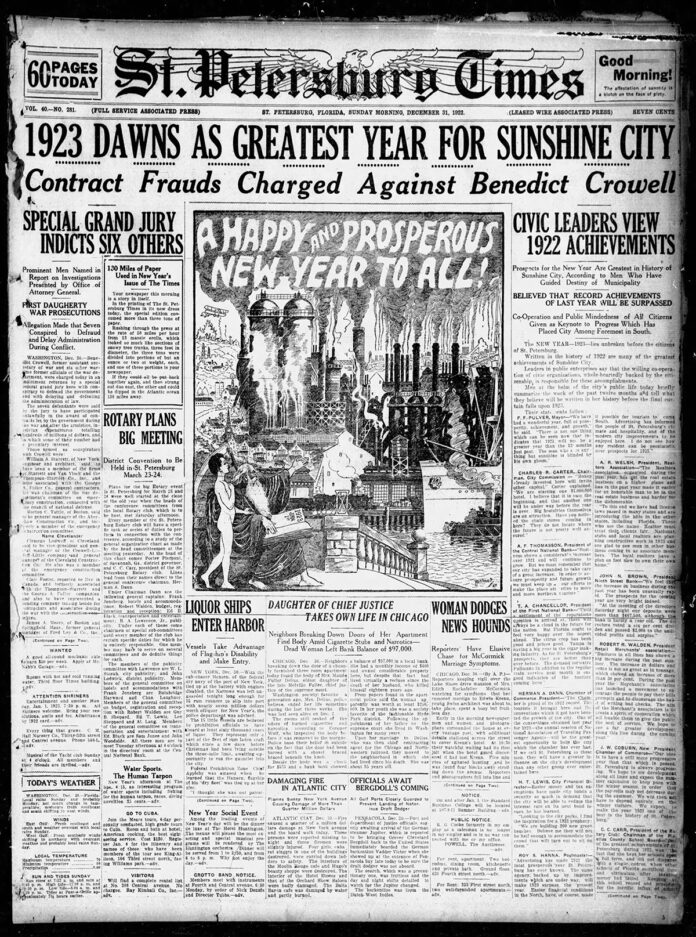One hundred years ago, the New Year’s Eve edition of the St. Petersburg Times declared, “1923 DAWNS AS GREATEST YEAR FOR SUNSHINE CITY.” This enthusiastic assumption regarding the community’s future was founded on the seemingly unstoppable triumphs of the previous year. Hindsight offers a blinder-free understanding of the fragility of that assumption, but in that moment, relentless optimism ruled.

“The Man Who Sees Anything But Sunshine is Blinded By His Own Gloom.”
On Oct. 25, 1921, Tampa Bay was hit by the most destructive hurricane since 1848. A storm surge of up to 11 feet wreaked havoc on many coastal locations. Damage included the loss of St. Petersburg’s city pier, but the village narrowly escaped the worst of the storm. Two days later, the sun shone on the “Queen of the West Coast,” and locals seemed ready to look to the future. According to the local paper, “whiners” would get “little hearing” as the “City Comes Up Smiling After Storm Passes.” The fact that St. Pete was already “open for business” proved its “right to reign supreme remains undisputed.” Two months later, Frank Pulver stepped into the role of mayor. His fun-loving, “billionaire bachelor” antics seemed to epitomize the sunny confidence that Sunshine City boosters wanted. Always decked out in a snow-white suit, Pulver was known for his city-boosting publicity stunts that often caught the attention of the national press. As his first full year in office ended, his trust in the future supremacy of “sunshine” looked to be a secure bet. The Saints, the local minor-league team, had even secured the first pennant St. Pete “ever copped in baseball.” It seemed nothing could stop the city’s momentum.
“Have You Noticed the Chair Stores?”
The foundation for this upward swing began in 1921 with expanding new construction, including the new Waterfront Park stadium where the Saints played. It hit full stride in 1922. No expense was spared to pave, construct, and extend roadways and bridges as the city embraced the idea of the automobile. Dealerships sprang up everywhere, and you could barely turn a page in the Times without seeing an advertisement for a must-have new Dodge, Ford, or Cadillac. Construction of the Gandy Bridge began in December 1922 with a pledge that those new automobiles would drive across the bay on Jan. 1, 1924. This can-do “Gandy spirit” also permeated building construction as more than $4 million worth of work began in 1922. The new construction included homes, hotels, banks, churches, and theaters, as well as the Haines Building, which provided an impressive new location for the rapidly growing Willson-Chase Department Store. In total, the city added more than 5,200 rooms, 670 houses, and 50 apartments in 1922 as its footprint spread up and out. According to one local leader, the real sign of “sure prosperity” was Willson-Chase’s new-furniture department and a plethora of new “chair stores,” as they open in places where the future is “well assured.”

“Everyone Is Made to Feel at Home in ‘Dream City’ of the South”
Multiplying “chair stores” may have signified prosperity, but most civic leaders viewed tourism as the real key to success. By year’s end, more than 10,000 visitors had been registered by the Chamber of Commerce, besting the 1921 total by nearly 2,500 people. Room availability could not keep pace; many visitors chose venues like Leora Lewis’ Tent City, where a campsite could be rented for $50 per season. According to an unnamed St. Pete booster, the beautiful setting was part of the reason for these record-breaking numbers, but most tourists came because “visitors find welcome here.” The Tourist News kept visitors up to date on the many offerings that catered to the seasonal swell, from multiple gaming clubs at Williams Park and evening concerts on the newly rebuilt Municipal Pier to the Boston Braves’ spring-training baseball games at Waterfront Park and shows at La Plaza Theater. In 1922, this celebration of tourism also saw the extravagant return of the Festival of States. Last held before World War I, the expanded weeklong festival in March included an opening “parade of states” with state-sponsored floats and 300 history-themed decorated cars, a carnival, a regatta, and a closing costumed “Dance of the Sun Worshippers” parade. Approximately 20,000 people watched the fireworks that topped off the self-described “greatest spectacle in history of the city.”
“Building 200 New Green Benches”
St. Pete’s seemingly unstoppable rise prompted the city to announce it was “building 200 new green benches” and predicted that “they will not be half enough to accommodate the crowd” of tourists expected the next year. Although marketed as a sign of welcome, the green benches are a reminder that in 1922, not “everyone is made to feel at home.” By 1922, the Jim Crow era of segregation and intimidation had been firmly established. Subsequently, although African Americans made up nearly 20% of the city’s population, they and Black tourists were denied access to most of the places and things celebrated by Sunshine City boosters, including those ubiquitous green benches. As we look back at the frenetic highs of 1922’s boom, it’s vital to remember the lows of that year as well. We can learn from both.
Sources available on request.



